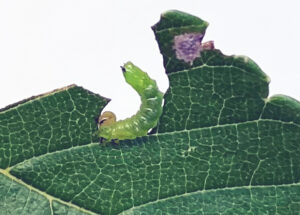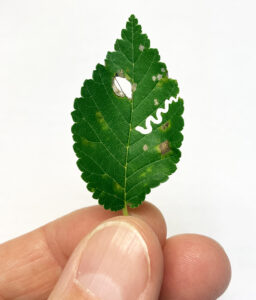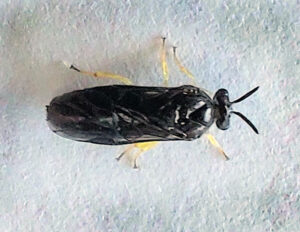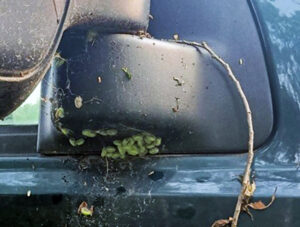By Art Kabelowsky, DNR Outreach and Communications, Fitchburg;
Arthur.Kabelowsky@wisconsin.gov or 608-335-0167

A closeup of an elm zigzag sawfly caterpillar consuming a leaf. The invasive insect, new to Wisconsin, was found on an elm tree near the Wisconsin Department of Natural Resources office in Oshkosh on July 16, 2024. / Photo Credit: Bill McNee, Wisconsin DNR
The invasive insect elm zigzag sawfly (Aproceros leucopada) has been detected in Wisconsin for the first time.
Following the initial Wisconsin discovery in Portage County on July 4. Through Aug. 12, the pest has since been detected in 17 Wisconsin counties.
Samples sent to the United States Department of Agriculture Animal and Plant Health Inspection Service have been confirmed to be elm zigzag sawfly. The Wisconsin Department of Agriculture, Trade and Consumer Protection reports that there are no current or planned federal or state quarantines for elm zigzag sawfly.

A closeup of a leaf showing damage from an elm zigzag sawfly. The invasive insect is new to Wisconsin. The leaf was found near the Wisconsin Department of Natural Resources office in Oshkosh on July 16, 2024. / Photo Credit: Bill McNee, Wisconsin DNR
The pest feeds only on elm trees (Ulmus spp.). In many cases, the feeding causes minor cosmetic damage. However, the insect does have the potential to cause significant defoliation in some localized cases. Repeated severe damage can weaken trees and lead to branch dieback, potentially impacting the long-term health and value of landscape and forest trees.
A distinctive trait of elm zigzag sawfly (EZS) is the meandering zigzag pattern chewed by young larvae in elm leaves. Older larvae consume a greater amount of leaf material, creating large notches in leaves.
Elm zigzag sawfly, native to parts of East Asia, was first detected in Europe in 2003 and in North America in 2020 (in Quebec, Canada). It was first found in the United States in Virginia in 2021 and has been moving westward, with detections confirmed in at least 10 states.
The EZS population consists entirely of females. They reproduce through parthenogenesis, laying viable eggs without mating.

An adult elm zigzag sawfly discovered in Oshkosh on July 26, 2024. / Photo Credit: Bill McNee, Wisconsin DNR
The insect can create multiple generations in a single year, and each generation can contribute to the defoliation of a single tree. One to four generations in a single year have been reported in eastern states. Each generation can contribute to the defoliation of a single tree.
Adults are capable of long-distance dispersal and have been observed moving up to 56 miles per year. Cocoons are sticky and can attach to man-made items such as vehicles and outdoor furniture, creating a nuisance and further facilitating long-distance movement.
Elm trees produce an abundance of leaves and can generally tolerate some insect feeding without any concern. In many cases, doing nothing to control an elm zigzag sawfly infestation may be an appropriate course of action. Management may be warranted to help preserve the health of high-value trees.

A number of elm zigzag sawfly pupa rest under the side mirror attachment of a truck in Pierce County in July 2024.
Larvae can be blasted off leaves with a stream from a garden hose, or can be squashed, hand-picked or scraped into a container of soapy water. However, these labor-intensive options are most appropriate for small landscape trees.
Options for organic and reduced-impact sprays can include insecticidal soap, horticultural oils, pyrethrins, Spinosad and azadirachtin — the same options commonly used to control other sawfly pests. Multiple applications will likely be needed to maximize effectiveness, and these options could be most appropriate for smaller trees that can be sprayed easier.
In many infestation situations, it may be best to consult a certified arborist to assess tree health and discuss management options.
Visit the University of Wisconsin-Madison Extension website for more information about the species, including management options.
